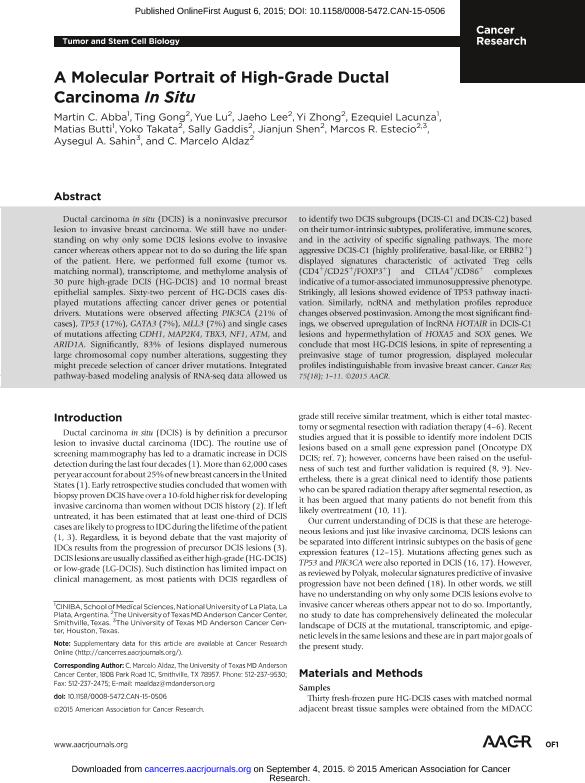Artículo
A molecular portrait of high-grade Ductal Carcinoma in situ
Abba, Martín Carlos ; Gong, Ting; Lu, Yue; Lee, Jaeho; Zhong, Yi; Lacunza, Ezequiel
; Gong, Ting; Lu, Yue; Lee, Jaeho; Zhong, Yi; Lacunza, Ezequiel ; Butti, Matias; Takata, Yoko; Gaddis, Sally; Shen, Jianjun; Estecio, Marcos R.; Sahin, Aysegul A.; Aldaz, Marcelo
; Butti, Matias; Takata, Yoko; Gaddis, Sally; Shen, Jianjun; Estecio, Marcos R.; Sahin, Aysegul A.; Aldaz, Marcelo
 ; Gong, Ting; Lu, Yue; Lee, Jaeho; Zhong, Yi; Lacunza, Ezequiel
; Gong, Ting; Lu, Yue; Lee, Jaeho; Zhong, Yi; Lacunza, Ezequiel ; Butti, Matias; Takata, Yoko; Gaddis, Sally; Shen, Jianjun; Estecio, Marcos R.; Sahin, Aysegul A.; Aldaz, Marcelo
; Butti, Matias; Takata, Yoko; Gaddis, Sally; Shen, Jianjun; Estecio, Marcos R.; Sahin, Aysegul A.; Aldaz, Marcelo
Fecha de publicación:
09/2015
Editorial:
American Association For Cancer Research
Revista:
Cancer Research
ISSN:
0008-5472
e-ISSN:
1538-7445
Idioma:
Inglés
Tipo de recurso:
Artículo publicado
Clasificación temática:
Resumen
Ductal carcinoma in situ (DCIS) is a noninvasive precursor lesion to invasive breast carcinoma. We still have no understanding on why only some DCIS lesions evolve to invasive cancer whereas others appear not to do so during the life span of the patient. Here, we performed full exome (tumor vs. matching normal), transcriptome, and methylome analysis of 30 pure high-grade DCIS (HG-DCIS) and 10 normal breast epithelial samples. Sixty-two percent of HG-DCIS cases displayed mutations affecting cancer driver genes or potential drivers. Mutations were observed affecting PIK3CA (21% of cases), TP53 (17%), GATA3 (7%), MLL3 (7%) and single cases of mutations affecting CDH1, MAP2K4, TBX3, NF1, ATM, and ARID1A. Significantly, 83% of lesions displayed numerous large chromosomal copy number alterations, suggesting they might precede selection of cancer driver mutations. Integrated pathway-based modeling analysis of RNA-seq data allowed us to identify two DCIS subgroups (DCIS-C1 and DCIS-C2) based on their tumor-intrinsic subtypes, proliferative, immune scores, and in the activity of specific signaling pathways. The more aggressive DCIS-C1 (highly proliferative, basal-like, or ERBB2þ) displayed signatures characteristic of activated Treg cells (CD4þ/CD25þ/FOXP3þ) and CTLA4þ/CD86þ complexes indicative of a tumor-associated immunosuppressive phenotype. Strikingly, all lesions showed evidence of TP53 pathway inactivation. Similarly, ncRNA and methylation profiles reproduce changes observed postinvasion. Among the most significant findings, we observed upregulation of lncRNA HOTAIR in DCIS-C1 lesions and hypermethylation of HOXA5 and SOX genes. We conclude that most HG-DCIS lesions, in spite of representing a preinvasive stage of tumor progression, displayed molecular profiles indistinguishable from invasive breast cancer.
Palabras clave:
Ductal Carcinoma in Situ
,
Breast Cancer
,
Gene Expresssion
Archivos asociados
Licencia
Identificadores
Colecciones
Articulos(CCT - LA PLATA)
Articulos de CTRO.CIENTIFICO TECNOL.CONICET - LA PLATA
Articulos de CTRO.CIENTIFICO TECNOL.CONICET - LA PLATA
Citación
Abba, Martín Carlos; Gong, Ting; Lu, Yue; Lee, Jaeho; Zhong, Yi; et al.; A molecular portrait of high-grade Ductal Carcinoma in situ; American Association For Cancer Research; Cancer Research; 75; 18; 9-2015; 1-11
Compartir
Altmétricas



